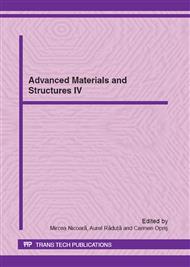[1]
R. W. Baker, Membrane Technology and Apllications, John Wiley&Sons Ltd., 2nd ed., 2006, p.538.
Google Scholar
[2]
S. Vercauteren, K. Keizer, E.F. Vansant, J. Luyten, R. Leysen, Porous Ceramic Membranes: Preparation, Transport Properties and Applications, J. Porous Mater., 5, 1998, pp.241-258.
DOI: 10.1023/a:1009634305315
Google Scholar
[3]
J. A. Suarez, J. M. Veza, Dead-end Microfiltration as Advanced Treatment for Wastewater, Desalination, 127, 2000, pp.47-58.
DOI: 10.1016/s0011-9164(99)00191-5
Google Scholar
[4]
W. J. Tseng, C. H. Wu, Sedimentation, Rheology and Particle-Packing Structure of Aqueous Al2O3 suspension, Ceramics Int., 29, 2003, pp.821-828.
DOI: 10.1016/s0272-8842(03)00023-3
Google Scholar
[5]
W. J. Tseng, C. H. Wu, Aggregation, rheology and electrophoretic packing structure of aqueous Al2O3 nanoparticle suspensions, Acta Mater., 50, 2002, pp.3757-3766.
DOI: 10.1016/s1359-6454(02)00142-8
Google Scholar
[6]
J. Ma, L.C. Lim, Effect of Particle Size Distribution on Sintering of agglomerate-free submicron alumina powder compacts, J. European Ceramic Society, 22, 2002, pp.2197-2208.
DOI: 10.1016/s0955-2219(02)00009-2
Google Scholar
[7]
L. C. Lim, P. M. Wong, M. Jan, Microstructural Evolution During Sintering of Near-Monosized Agglomerate-free submicron Alumina Powder Compacts, Acta Mater., 48, 2000, pp.2263-2275.
DOI: 10.1016/s1359-6454(00)00031-8
Google Scholar
[8]
K. S. Chou, K.B. Kao, C.D. Huang, C.Y. Chen, Coating and Characterization of Titania Membrane on Porous Ceramic Supports, J. of Porous Materials, Kluwer Academic Publishers, 6,1999, pp.217-225.
Google Scholar
[9]
M. Bram, H.P. Buchkremer, D. Stover, Development of Porous Composite Membranes for Microfiltration Devices, Proc. of Euro PM2004, 2004, pp.183-188.
Google Scholar
[10]
V. V. Maziuk, V.V. Doctarau, A.L. Rak, Structure of Porous Powder Materials Obtained by Sedimentation Method, Proc. of Euro PM2005, Prague, Czech Republic, 2005, pp.187-172.
Google Scholar
[11]
I.Vida-Simiti, Sintered Permeable Materials, Ed. Science House Book, Cluj-Napoca, 1998.
Google Scholar
[12]
I.Vida-Simiti, High Porosity Sintered Sheets, J. Optoelectronics Adv. Mater., 8(4), 2006, pp.1479-1483.
Google Scholar
[13]
Vida-Simiti, N. Jumate, N. Sechel, Graded Porous Structure of Sintered Membranes Obtained by Powders Sedimentation, Proceedings - EUROPM 2008, Vol. 2, pp.195-200.
Google Scholar
[14]
Vida-Simiti, N. Jumate, N. Sechel, Sintered Porous Materials with Structural Gradient Obtained by Powders Sedimentation, Delegate Manual – Hybrid Materials 2009, First Int. Conf. Multifunctional, Hybrid and Nanomaterials, Tours, France, 2009, [C1.1.80].
Google Scholar
[15]
Vityaz P.A., Kaptzevich V.M., Sheleg V.K., (1987) Porous powder materials and products from them, (in Russian), Izd. Vysshaia shkola Minsk, Belarus.
Google Scholar
[16]
H. Pape, J.E. Tillich, M.J. Holz, Pore geometry of sandstone derived from pulsed field gradient NMR, Journal of Applied Geophysics. 58, 2006, p.232.
DOI: 10.1016/j.jappgeo.2005.07.002
Google Scholar
[17]
J. Navas, J. A. Poce-Fatou, J. J. Gallardo, J. Martin, Evaluation method for pore size distribution by using capillary liquid suction tests, Journal of Porous Materials 17, 2010 p.207.
DOI: 10.1007/s10934-009-9282-7
Google Scholar
[18]
A.M.J. Attia, Effects of petrophysical rock properties on tortuosity factor, Journal of Petroleum Science and Engineering, 48, 185 (2005).
DOI: 10.1016/j.petrol.2005.06.012
Google Scholar



